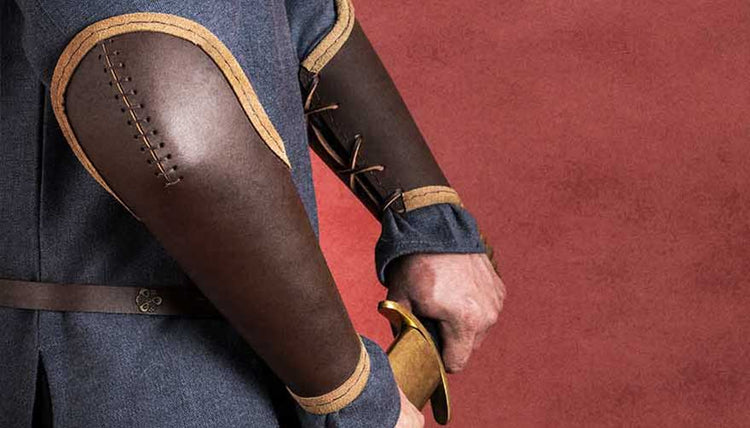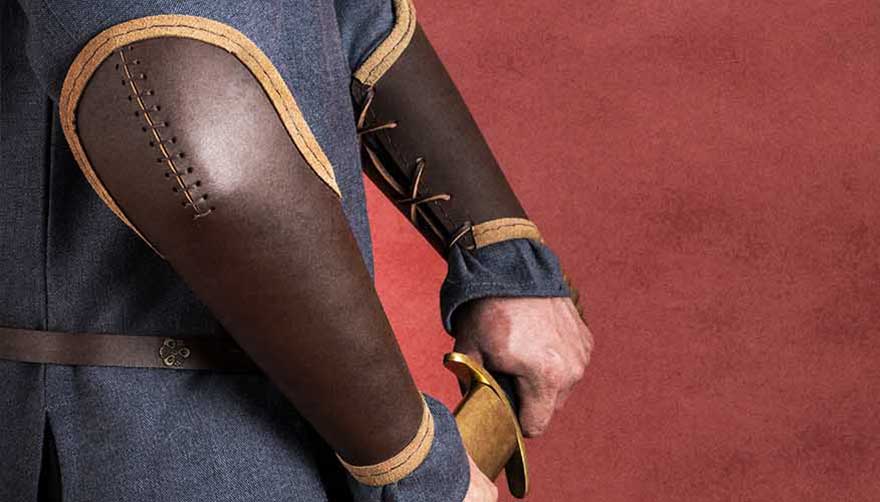Arm Guards
Arm guards and gauntlets were among a knight’s most important tools. Their strength and endurance were required when wielding heavy weapons for hours in battle or at a tournament. Whether it be a sword, morning star, or battle ax, the popular weapons of the Middle Ages often weighed several kilograms, and not only had to be lifted and held easily but had to be wielded with strength and endurance.
At the same time, arms were commonly the part of the body at the most risk for serious injury. Fight scenes in Hollywood movies look spectacular. In precise and elegant movements, knights swing their weapons, which reach their targets with the utmost precision. Certainly, knights in the Middle Ages were well-trained fighters who had undergone many hours of hard training, but in real battle, man-to-man combat was quite removed from the choreographed sequences of movements on the screen. A sword strike that misses its target, or is not perfectly deflected by a parry, in many cases hits an opponent’s arms first and foremost.
Meanwhile, even a light hit to unprotected arms could result in serious injuries and render a knight or soldier unable to fight or defend. Those who could no longer hold their weapons were usually doomed to die. Because fighters were well aware of this, the arms of their enemies were prime targets for attack. However, some effort was made at the time to protect one’s arms from injury.
Arm Splints - Strength and Protection
It was not only one’s opponent that could cause injuries to one’s arms. The risk of self-injury was also high, at least for certain types of weapons. For example, archers wore at least simple bracers made of leather to prevent injuries caused by the bowstring recoiling after an arrow was released.
A tight-fitting, tightly laced bracer could also give one’s arm additional stability and even strength through its pressure. In addition, a thrust or blow with the splinted arm could also ward off the opponent.
Until the early Middle Ages, little independent attention was paid to arm guards. Armoured shirts and chain armour reached over the arms and, supplemented by mesh mittens, formed simple but widespread protection. Only over the course of this era did bracers made of "boiled" leather for malleability appear.
From the High Middle Ages onwards, bracers made of iron are increasingly used. Early models, therefore, have little to do with the image we have today for the majority of bracers. Before complex metalworking and the possibility to shape close to the body by hand, bracers consisted of individual metal parts, such as flat irons, which were fastened to straps around the forearm. Even simple leather bracers were fitted with metal parts, for example, metal rivets, to give them additional resistance.
The classic plate armour of the late Middle Ages implements arm protection, also referred to as arm tubes, which extend from the wrist, over the elbow, to about the middle of the upper arm. Visually and in their protective effect, such complete bracers form a unit with plate shoulders. As with plate shoulders, the mobility of the arm joints is maintained by the use of a riveted scale construction. On the side of the wrist, the splint could be additionally extended by a back of the hand guard, which provided elementary protection even when gloves were not worn.
Instead of complete bracers that also covered the elbows, separate armour for the elbows was also used, which could be worn over chain mail or a gambeson. Such elbow tiles, shells, or micelles were primarily intended to protect the outside of the elbow. However, the tubular design of the so-called whole tile proved rather impractical in battle and was supplanted by the half tile, which covered only the outside. Use was made of the closed variant as a handcrafted and artistically sophisticated piece of work in tournament armour until the 17th century.
Your Strong Arm
With bracers you can already ennoble and visually enhance your individual armour with lt at low entry prices.
You can equally wear them over a simple tunic or gambeson, or top off a chain armour with them. For complete plate armour, bracers are indispensable.
With Zeughaus, you will find a wide selection of different bracers from various materials and eras. By fastening with straps and bands, bracers are flexible and can easily be adapted to the garment worn underneath.
Whether your character is from LARP or reenactment, you will find the right model made of leather or metal. Leather bracers give you a particularly powerful appearance and can even be worn in everyday life with the appropriate enthusiasm and a pinch of self-confidence.


















